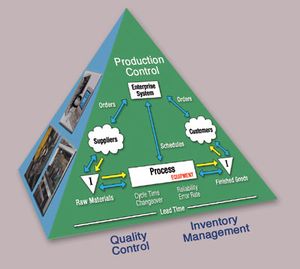Difference between revisions of "Manufacturing Execution Systems"
| Line 1: | Line 1: | ||
[[Category:Control Systems]]{{Knoppen}} | [[Category:Control Systems]]{{Knoppen}} | ||
[[File:Manufacturing execution system.jpg|thumb|right|Manufacturing Execution Systems]] | [[File:Manufacturing execution system.jpg|thumb|right|Manufacturing Execution Systems]] | ||
'''Manufacturing Execution System (MES)''' is a control system for managing and monitoring work-in-process on a factory floor. An MES keeps track of all manufacturing information in real time, receiving up-to-the-minute data from robots, machine monitors and employees. Although manufacturing execution systems used to operate as self-contained systems, they are increasingly being integrated with Enterprise Resource Planning (ERP) software suites. The goal of a manufacturing execution system is to improve productivity and reduce cycle-time, the total time to produce an order. By integrating an MES with ERP software, factory managers can be proactive about ensuring the delivery of quality products in a timely, cost-effective manner. | '''Manufacturing Execution System (MES)''' is a control system for managing and monitoring work-in-process on a factory floor. An MES keeps track of all manufacturing information in real time, receiving up-to-the-minute data from robots, machine monitors and employees. Although manufacturing execution systems used to operate as self-contained systems, they are increasingly being integrated with Enterprise Resource Planning (ERP) software suites. The goal of a manufacturing execution system is to improve productivity and reduce cycle-time, the total time to produce an order. By integrating an MES with ERP software, factory managers can be proactive about ensuring the delivery of quality products in a timely, cost-effective manner. | ||
Latest revision as of 03:21, 11 December 2012
Manufacturing Execution System (MES) is a control system for managing and monitoring work-in-process on a factory floor. An MES keeps track of all manufacturing information in real time, receiving up-to-the-minute data from robots, machine monitors and employees. Although manufacturing execution systems used to operate as self-contained systems, they are increasingly being integrated with Enterprise Resource Planning (ERP) software suites. The goal of a manufacturing execution system is to improve productivity and reduce cycle-time, the total time to produce an order. By integrating an MES with ERP software, factory managers can be proactive about ensuring the delivery of quality products in a timely, cost-effective manner.
Manufacturing execution system (MES) software is used to manage and monitor work-in-process on the factory floor. Plant managers and production personnel use MES software to support collaborative manufacturing strategies that are designed to integrate disparate data streams from a company’s supply chain, factory floor, and enterprise resource planning (ERP) system. Selecting manufacturing execution system (MES) software requires a detailed analysis of capabilities and features. Some products provide operator instructions for each stage of production. Others provide finite scheduling, workflow management, resource planning, and quality analysis (QA) features. Most MES software is designed to improve asset productivity, reduce order-to-ship times, and eliminate costly rework. Typically, industries that implement manufacturing execution system (MES) software treat cycle-time, the total time to produce an order, as a key performance indicator (KPI).
Machine monitoring sensors and shop floor data collection (SFDC) terminals transmit production data from the factory floor to manufacturing execution system (MES) software. MES software that includes supervisory control and data acquisition (SCADA) features can collect data from machine-mounted sensors. This information is then transmitted to a central computer for processing. In turn, software-based algorithms send real-time instructions to devices such as programmable logic controllers (PLC). Some manufacturing execution system (MES) software is designed for use with manual SFDC terminals. With these systems, users enter information such as job numbers, labor codes, and production counts. Manufacturing execution system (MES) software can be used to schedule tasks by facility, work center, machine, and/or employee skill set.
